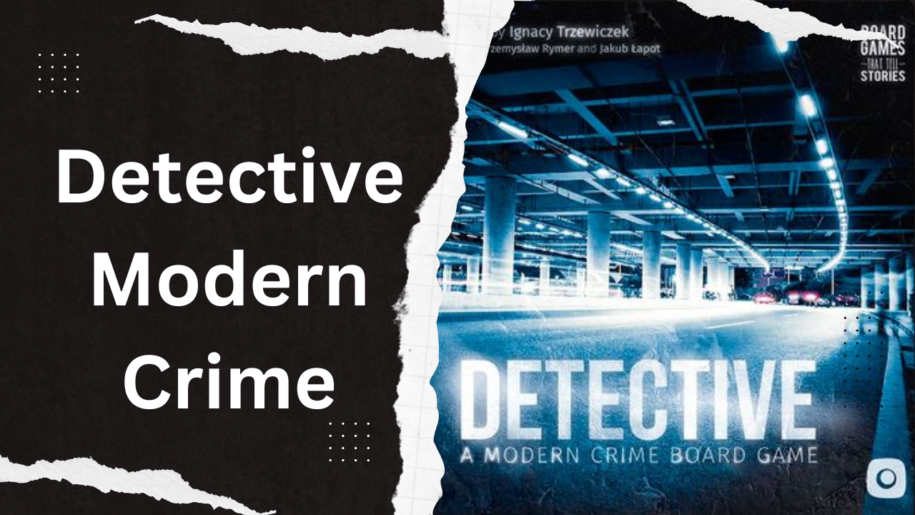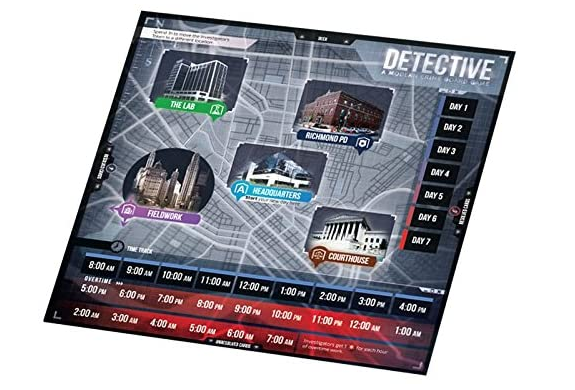
Because of the nature of the content, A Modern detective Crime Board Game is appropriate for players aged 16 and above. It is a completely cooperative game for 1 to 5 players. Detective is a five-session game that is classified as a campaign because you have to solve a different case in each session. Every case is connected to the others, and the resolution of one will affect others.
As the name implies, detective is a deduction-based game. To determine which hints are significant and which aren’t, you’ll need to apply your interpretation abilities and ability to read between the lines. It is your job as Antares National Investigation Agency members to solve the puzzles and turn the tide.
Game components include
- Five case decks with thirty-five cards each
- One game board with the five game locations and a time and day tracker
- One casebook with an introduction to each case
- Five double-sided character tiles with investigators and consultants on opposite sides
- Thirty character tokens, comprising fifteen Authority tokens, ten Stress tokens, five Used Ability tokens, five Special tokens, three wooden markers, and seventeen skill tokens (three Tech, three research, three perception, three questioning, and five wild).
GamePlay
Detective is a hybrid cooperative game that combines electronic and physical components. Its gameplay consists of deduction, investigation, and narration. Detective cases are investigated using decks and the Antares database, which may be accessed at https://antaresdatabase.com, as opposed to other games like Sherlock Holmes Consulting Detective, where each case is narratively included in a casebook.

A police agency database is simulated on the internet, and each deck has 35 cards. You receive access to a variety of identifying methods related to dactyloscopic, material, and DNA markers, and you can search by name, file, query, or other. Furthermore, the game encourages users to freely explore the internet to learn more about a topic.
The game is primarily freeform, with a straightforward idea. Every player takes control of a distinct kind of investigator. Collaboratively, they collect hints, attempt to decipher the rational links among them, and resolve the case at hand. Cases can only be resolved in a rigid, sequential fashion. It is not possible to attempt a case before you have attempted the last one, regardless of the outcome.
They are limited in their discussion because the game has an inbuilt clock that determines how many hours you can work each day. Investigators are able to put in long hours, yet doing so causes stress. There is a stress threshold for every case that the investigators must not cross. If they do, they have to write their final report to wrap up the matter before their investigation period ends.
Whether it is turned in on time or ahead of schedule, the final report has two sets of questions. The case at hand is related to the first series, and the metaplot is related to the second. More points are handled by the first series than by the second. In addition, players lose points for the stress they accrued during their investigations and gain points for each piece of matched evidence they enter in the database. They can see their score and whether or not they solved the case in the game. If it is resolved, they can go on to the following case. If not, they can move on to the next case or give it another shot.
Setup of the Game
Setting up the game is not too difficult. Since each case builds upon the one before it, you must start with Case 1 if you are starting a fresh copy of the game.
Detective: A Contemporary Crime A campaign game is a board game. The narrative picks up in Case 1 and culminates in Case 5, where it is concluded.
We assembled the board by taking the inquiry cards from the previous case and arranging the automobile, calendar, and clock meeples on it. after which we selected Case 1 and set up our Antares Database Account. We assembled our token pool and selected our roles. After grabbing the casebook and reading Case 1’s introduction, we were set to go!

Lead Cards
You will receive additional details about the case narrative with each Lead card. You could find out what’s at the crime scene, for example, by consulting Crime Scene – #103. The cards frequently have an A and a B side. The card will either instruct you to flip it over or require you to use an extra skill token to do so at the bottom of the A-side. Keeping track of your skill tokens is essential to the gameplay.
You will have to make a decision right away about whether to use the token to flip the card as you read the lead card. You won’t be able to see the card’s reverse for the duration of the Campaign if you decide not to turn it.
We advise you to spend a token if you are able to. Most card backs have more pertinent information, let you add tokens to the pool, or give you verification that lets you access the database.
Conclusion
A lot of my complaints about the first game were taken and blended into the first season of Detective: A Modern Crime Board Game. The result was a more simplified game that centres on following leads and solving crimes, like it should.True, Detective’s fundamentals remain the same. Therefore, this probably won’t be the game for you if you didn’t enjoy the digital integration or the time-limited lead system.
Season One is simply a better experience than its predecessor for everyone else, and I hope Portal Games keeps this in mind moving ahead. They were able to take an already fantastic game and turn it into something I truly enjoyed playing. This is the fantastic version of Detective that I wish to play.
